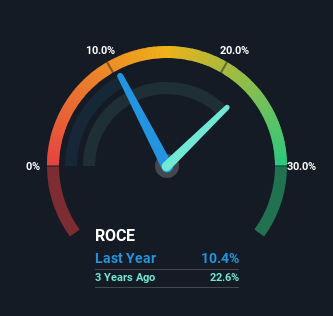Be Wary Of Zhejiang Oceanking Development (SHSE:603213) And Its Returns On Capital
If we want to find a stock that could multiply over the long term, what are the underlying trends we should look for? One common approach is to try and find a company with returns on capital employed (ROCE) that are increasing, in conjunction with a growing amount of capital employed. Put simply, these types of businesses are compounding machines, meaning they are continually reinvesting their earnings at ever-higher rates of return. However, after investigating Zhejiang Oceanking Development (SHSE:603213), we don't think it's current trends fit the mold of a multi-bagger.
Return On Capital Employed (ROCE): What Is It?
For those who don't know, ROCE is a measure of a company's yearly pre-tax profit (its return), relative to the capital employed in the business. To calculate this metric for Zhejiang Oceanking Development, this is the formula:
Return on Capital Employed = Earnings Before Interest and Tax (EBIT) ÷ (Total Assets - Current Liabilities)
0.10 = CN¥284m ÷ (CN¥3.4b - CN¥688m) (Based on the trailing twelve months to March 2024).
So, Zhejiang Oceanking Development has an ROCE of 10%. On its own, that's a standard return, however it's much better than the 5.5% generated by the Chemicals industry.
See our latest analysis for Zhejiang Oceanking Development

While the past is not representative of the future, it can be helpful to know how a company has performed historically, which is why we have this chart above. If you're interested in investigating Zhejiang Oceanking Development's past further, check out this free graph covering Zhejiang Oceanking Development's past earnings, revenue and cash flow.
What Can We Tell From Zhejiang Oceanking Development's ROCE Trend?
On the surface, the trend of ROCE at Zhejiang Oceanking Development doesn't inspire confidence. Over the last five years, returns on capital have decreased to 10% from 40% five years ago. Given the business is employing more capital while revenue has slipped, this is a bit concerning. This could mean that the business is losing its competitive advantage or market share, because while more money is being put into ventures, it's actually producing a lower return - "less bang for their buck" per se.
On a side note, Zhejiang Oceanking Development has done well to pay down its current liabilities to 20% of total assets. So we could link some of this to the decrease in ROCE. What's more, this can reduce some aspects of risk to the business because now the company's suppliers or short-term creditors are funding less of its operations. Some would claim this reduces the business' efficiency at generating ROCE since it is now funding more of the operations with its own money.
What We Can Learn From Zhejiang Oceanking Development's ROCE
From the above analysis, we find it rather worrisome that returns on capital and sales for Zhejiang Oceanking Development have fallen, meanwhile the business is employing more capital than it was five years ago. Investors haven't taken kindly to these developments, since the stock has declined 34% from where it was year ago. With underlying trends that aren't great in these areas, we'd consider looking elsewhere.
On a final note, we found 2 warning signs for Zhejiang Oceanking Development (1 is significant) you should be aware of.
While Zhejiang Oceanking Development may not currently earn the highest returns, we've compiled a list of companies that currently earn more than 25% return on equity. Check out this free list here.
Valuation is complex, but we're here to simplify it.
Discover if Zhejiang Oceanking Development might be undervalued or overvalued with our detailed analysis, featuring fair value estimates, potential risks, dividends, insider trades, and its financial condition.
Access Free AnalysisHave feedback on this article? Concerned about the content? Get in touch with us directly. Alternatively, email editorial-team (at) simplywallst.com.
This article by Simply Wall St is general in nature. We provide commentary based on historical data and analyst forecasts only using an unbiased methodology and our articles are not intended to be financial advice. It does not constitute a recommendation to buy or sell any stock, and does not take account of your objectives, or your financial situation. We aim to bring you long-term focused analysis driven by fundamental data. Note that our analysis may not factor in the latest price-sensitive company announcements or qualitative material. Simply Wall St has no position in any stocks mentioned.
About SHSE:603213
Zhejiang Oceanking Development
Engages in the research, development, production, and sale of chlor-alkali-related products.
Excellent balance sheet with low risk.
Market Insights
Community Narratives



